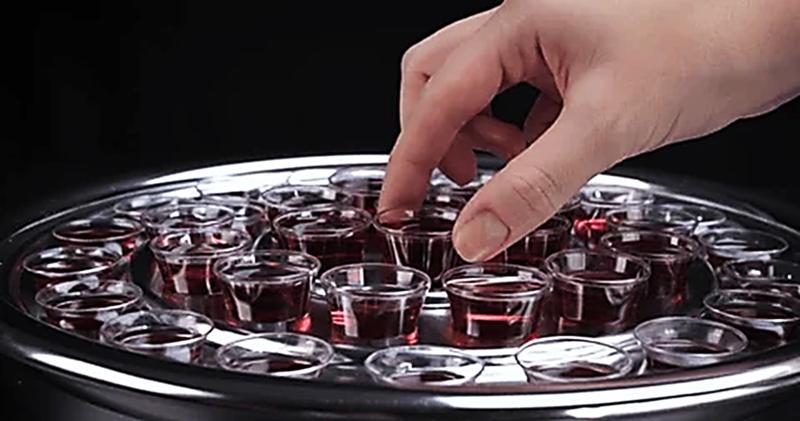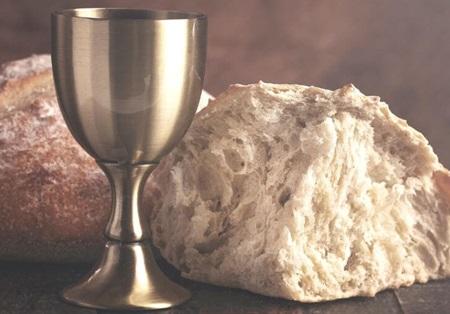Individual Cups for the Lord’s Supper?
Individual Cups for the Lord’s Supper?

It appears that the question of individual cups versus the common cup is a recurring with greater frequency, and I would like to offer my thoughts on this subject.
Scriptural Basis⤒🔗
There is certainly no scriptural basis for the use of individual cups. On the contrary. Both the Gospels according to St. Matthew and St. Luke state that on the night of His betrayal, our Lord “took the cup.” St. Paul, in writing to the Christians gathered at Corinth, also speaks of the cup (1 Corinthians 10:16; 1 Corinthians 11:25). These very words are quoted verbatim in the “Form for the celebration of the Lord's Supper” in the Book of Praise.
Spiritual Basis←⤒🔗
As if the scriptural basis were not enough, the use of individual cups is contrary to the whole spirit of communion. St. Paul employs the Eucharist as an paradigm of the Church's unity in 1 Corinthians 10:16. The Body of Christ, which we receive from one loaf, and likewise the drinking from one cup, reflect that we are one in Christ. Hymn 46, based on the Didache, speaks of the unity that the Lord's Supper demonstrates: “As grain, once scattered on the hillsides, was in the broken bread made one.”
Historical Basis←⤒🔗
From the Apostolic Church until now, the unbroken tradition has been to follow the precedent established by our Lord Jesus Christ of using a common cup. It is worth noting that, even though at the ritual Passover meal there would have been more than one cup available, Jesus explicitly commands His disciples “drink ye all of it” – not “drink ye all of them.”1
Justin Martyr (100-165) in his description of the Eucharist says: “Then bread and a cup containing wine and water are presented to the one presiding over the brothers.” The Antiochene chalice, one of the oldest extant Eucharistic vessels,2 is an amazingly large cup. Once again, demonstrative of the practice of the common cup. Moreover, the Reformers purged many abuses that had come into practice of the Roman Catholic Church, but neither Jean Calvin nor Dr. Martin Luther did away with the common cup.3
Origin of Individual Cups←⤒🔗
The introduction of the individual cups is a recent phenomenon. At the beginning of the twentieth century, professors Friedrich Spitta and Julius Smend recommended the use of individual cups for the Evangelical Lutheran Church in Europe, mainly on aesthetic and hygienic grounds. However, the desire for real table fellowship weighed more heavily than aesthetic and hygienic considerations, and the use of individual cups was rejected.4

On the North American continent, the introduction of individual cups originated in those churches that do not regard the mystery of this wonderful sacrament, which is so well expressed in article 35 of The Belgic Confession.5 This influence appears to be gaining foothold in the Canadian and American Reformed churches, almost entirely on the basis of the supposed hygienic advantages of individual cups over the common cup.
Cleanliness←⤒🔗
The public health issue has gained more attention with the present-day concern over the acquired immune deficiency syndrome. Research has shown, however, that one does not get AIDS from the common cup. Moreover, the common cup is from a hygienic point of view of disease control the cleanest means for Holy Communion – more sanitary, indeed, than individual cups; it is after all our hands which are most likely to transmit diseases, and each individual glass is handled probably right on the drinking rim, because of the small size.6 Indeed, it is almost sacrilegious to speak of sanitation in connection with the Lord's Supper and it is difficult to imagine the Apostles hesitating to receive the one cup from their Lord in fear of another's germs.7
Conclusion←⤒🔗
The introduction of individual cups is a recent phenomenon, that differs from the scriptural practice of the church. No biblical rationale is provided for a deviation of the liturgical practice of the church, and the supposed hygienic concerns have been proven wrong. Moreover, individual cups are directly contrary to the meaning of communion. St. Paul, in his first letter to the Christians at Corinth (chapter 10, vv. 16-17) stresses the importance of the elements of the Eucharist as the symbol for Christian unity: just as we receive the Body of Christ from one loaf, and drink the Blood of Christ from one cup, so we are one body in Christ.8
Drs. Pfatteicher and Messerli comment:
The use of pre-filled individual glasses destroys the significance of the one cup, is excessively individualistic (which is contrary to the spirit of the sacrament), and is totally undesirable historically and theologically. The use of paper cups is distasteful aesthetically, liturgically, and theologically; and disposal cups of plastic or paper are the product of a garbage-producing, throwaway culture that respects neither the creation nor the sacramental element.9

The foregoing clearly demonstrates that the use of individual cups has no scriptural, spiritual, historical, and hygienical basis. The common cup, on the other hand does.
May the above observations stimulate further thought, so that appropriate scriptural, historical, and spiritual consideration will be given to the issue of individual cups versus the common cup in the Lord's Supper.

Add new comment